Deleted
Deleted Member
Posts: 0
|
Post by Deleted on Apr 4, 2017 2:09:24 GMT -5
Another episode from the Kazakh TV series.
Martial Arts of a Turkic world: The Turkic-Mongolian Peoples in the XII century.
|
|
|
|
Post by deuce on Apr 4, 2017 8:14:31 GMT -5
You can find this map of the Mongol Empire published in 1830 and lots of other antique maps here: www.ritzlin.com/gallery/l99.htmlThe map shop proprieters are retiring, so I don't know how long the site will be up.  |
|
Deleted
Deleted Member
Posts: 0
|
Post by Deleted on Apr 10, 2017 13:21:17 GMT -5
Etymological Dictionary of the Altaic Languages (3 vols) by Sergei Starostin, Anna Dybo, Oleg Mudrak. With assistance of Ilya Gruntov and Vladimir Glumov, Brill, 2003.
Description:
This comparative and etymological dictionary of the more than fifty languages traditionally classified as Altaic is arguably the most comprehensive, systematic work as yet on the subject.
Subdivided into five branches: Turkic, Mongolian, Tungus-Manchu, Korean and Japanese, it deals with the entire Altaic family.
The introduction contains a detailed account of the phonetic correspondences between Altaic languages, as well as their morphological and lexical characteristics.
The body of the dictionary presents almost 3000 lexical matches between different subgroups of Altaic, with Proto-Altaic reconstructions and detailed reflexes in ancient and modern languages. Wherever possible comments are given to distinguish between inherited vocabulary and various later interlingual borrowings.
With detailed indices for each language. A true reference work of great importance.
Contributors:
Sergei Starostin is a member of the Russian Academy of Sciences and co-organizer of the Evolution of Human Languages program in the Santa Fe Institute, USA. He has published extensively on historical linguistics and Altaic languages, including The Altaic Problem and the Origin of Japanese (Moscow, 1991).
Anna Dybo, Ph.D. (1992), Institute of Linguistics, Russian Academy of Sciences, has published extensively in the fields of Turcology and Tungus-Manchurology. Her main work is
Semantic reconstruction in Altaic Etymology (Moscow, 1996).
Oleg Mudrak, Ph.D. (1994), Institute of Linguistics, Russian Academy of Sciences is Professor at the Russian State University of the Humanities. He is a well-known specialist in Altaic and Paleo-Siberian languages and author of Historical Correspondences of Chuvash and Turkic Vowels (Moscow, 1993).
|
|
Deleted
Deleted Member
Posts: 0
|
Post by Deleted on Apr 10, 2017 13:36:30 GMT -5
|
|
Deleted
Deleted Member
Posts: 0
|
Post by Deleted on Apr 13, 2017 1:05:03 GMT -5
The Empire of the Steppes: History of Central Asia by Rene Grousset, translated by N. Walford.This book is a great introduction to the subject and highly recommended!  Description: Description:
While the early history of the steppe nomad is shrouded in obscurity, The Empire of the Steppes brings both the general reader and the specialist the majestic sweep, grandeur and the overriding intellectual grasp of Grousset's original. Hailed as a masterpiece when first published in French in 1939, and in English in 1970, this great work of synthesis brings before us the people of the steppes, dominated by three mighty figures-Atilla, Genghiz Khan, and Tamberlain-as they marched through ten centuries of history, from the borders of China to the frontiers of the West. The book includes nineteen maps, a comprehensive index, notes, and bibliography. The late Rene Grousset was director of the Cernuschi Museum and curator of the Muse Guimet in Paris, a member of the French Academy and author of many works on Asia Minor and the Near East.
|
|
|
|
Post by deuce on Apr 14, 2017 7:37:20 GMT -5
|
|
Deleted
Deleted Member
Posts: 0
|
Post by Deleted on Apr 14, 2017 10:08:14 GMT -5
|
|
|
|
Post by deuce on Apr 14, 2017 14:25:15 GMT -5
|
|
Deleted
Deleted Member
Posts: 0
|
Post by Deleted on Apr 15, 2017 8:50:41 GMT -5
Thanks Deuce. Looks like they've done a good job cleaning up the Adidas boots  Here's a link to an earlier post on this thread. swordsofreh.proboards.com/thread/52/warriors-steppe-movies-music-art?page=5pics from the Siberian Times. 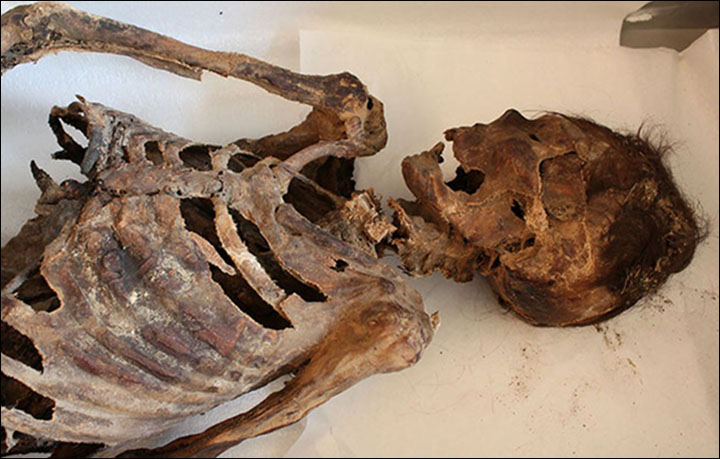 Adidas mummy, she is believed to have been aged between 30 and 40 - experts now believe on the basis of 18 samples taken from the mummy that it does not date from the 6th century AD, as first surmised, but rather from the 10th century, but DNA and radiocarbon testing is still awaited..  Knee length Adidas boots made of felt, with leather soles.  Stirrups.  The Turco-Mongol deel.  Horse was also sacrificed. It was a mare, between four and eight years old.  Wooden Saddle.  Felt Bag  Blade and scabbard. |
|
|
|
Post by deuce on Apr 15, 2017 14:06:59 GMT -5
NC Wyeth, from a 1932 issue of Good Housekeeping.  |
|
|
|
Post by deuce on Apr 15, 2017 19:42:10 GMT -5
Chepe Noyon/Jebe Noyan and Subotai at the Kalka River.  |
|
Deleted
Deleted Member
Posts: 0
|
Post by Deleted on Apr 18, 2017 15:38:19 GMT -5
Chepe Noyon/Jebe Noyan and Subotai at the Kalka River.  Nice pics Deuce. The first meeting between Genghis Khan and Jirqo’adai (Jebe), The Secret History of the Mongols, Section 148. ... Chinggis Qahan said:
‘We were fighting [the enemy] at Köyiten, slowly forcing each other to give ground, and deploying our troops when, from on top of that range, came an arrow that broke the nape of my yellow warhorse with the white mouth. Who shot [that arrow] from the mountain top?’
Jebe replied:
‘I shot the arrow from the mountain top. If I am to be put to death by the Qahan, then I shall be left to rot on a piece of ground [the size of] the palm [of a hand]. But if I am granted [mercy], then I shall go ahead on behalf of the Qahan.
I will attack for you:
I will slash the deep waters
and erode the shining stone.
At your word, I will go forwards
and smash the blue stones.
If you order me to attack,
I will smash the black stones.
I will attack for you."
Chinggis Qahan said:
‘[Faced with] those he has killed and with his enemies, the enemy hides and tells lies.[Here,] however, the contrary is true. [Faced with] those he has killed and with his enemies, [this man] does not deny [his feelings and his actions]. On the contrary, he admits them. [This] is a man to [have] as a companion. His name was Jirqo’adai, but because he shot at the nape of my yellow war-horse with the white mouth, he shall be called Jebe and I shall use him as an arrow.’
[So] he was called Jebe and ordered to walk at [Chinggis Qahan’s] side. This is how Jebe left the Tayichi’uts and became [Chinggis Qahan’s] companion.According to Urgench Onon: Jebe means ‘arrowhead’; jebelegü, a related word, means ‘to armour’. Thus by becoming Jebe, Jirqo’adai replaces the warhorse he has killed. Alternatively, he is so named because jebe is the type of arrow he used to kill the horse. His name will therefore be a permanent reminder to him both of his deed and of Chinggis Qahan’s mercy. |
|
Deleted
Deleted Member
Posts: 0
|
Post by Deleted on Apr 21, 2017 8:19:15 GMT -5
Silk-Covered Body Discovered at Inner Mongolia CemeteryThis cemetery is attributed to the nomadic Gaoche ( High-Chariots in Chinese) of the 5th century. The Gaoche are also known as the Tiele or Chile in Chinese sources. But their real name was Töles, at least in the early 8th century. According to the Chinese sources the Gaoche were the descendants of the Dingling nomadic confederacy (one of the 26 nations conquered by Modu, the founder of the Hunnu Empire). I apologize in advance for the uncertainty: If you wanna read more, and get even more confused - cos the Uyghurs and European Huns were possibly, probably, coulda, or may have been of Töles origin - well you can check out the wiki entry. en.wikipedia.org/wiki/Tiele_peopleen.wikipedia.org/wiki/Dingling www.livescience.com/58630-ancient-cemetery-found-inner-mongolia.html
|
|
Deleted
Deleted Member
Posts: 0
|
Post by Deleted on Apr 27, 2017 16:59:00 GMT -5
Genghis Khan: A Rare 10-Page Poem by Edgar Rice Burroughs.
Big thanks to Deuce for finding this rare poem. Genghis Khan is a 2,215-word, unfinished epic narrative poem consisting of 20 14-line stanzas. Written in December 1929 and January 1930.ERB submitted the manuscript on January 24, 1930 "Good Housekeeping Magazine" under the pseudeonym: Edar Burr c/o C. R. Rothmund, Box 625 Reseda, California. The poem was rejected. www.erbzine.com/mag58/5880.html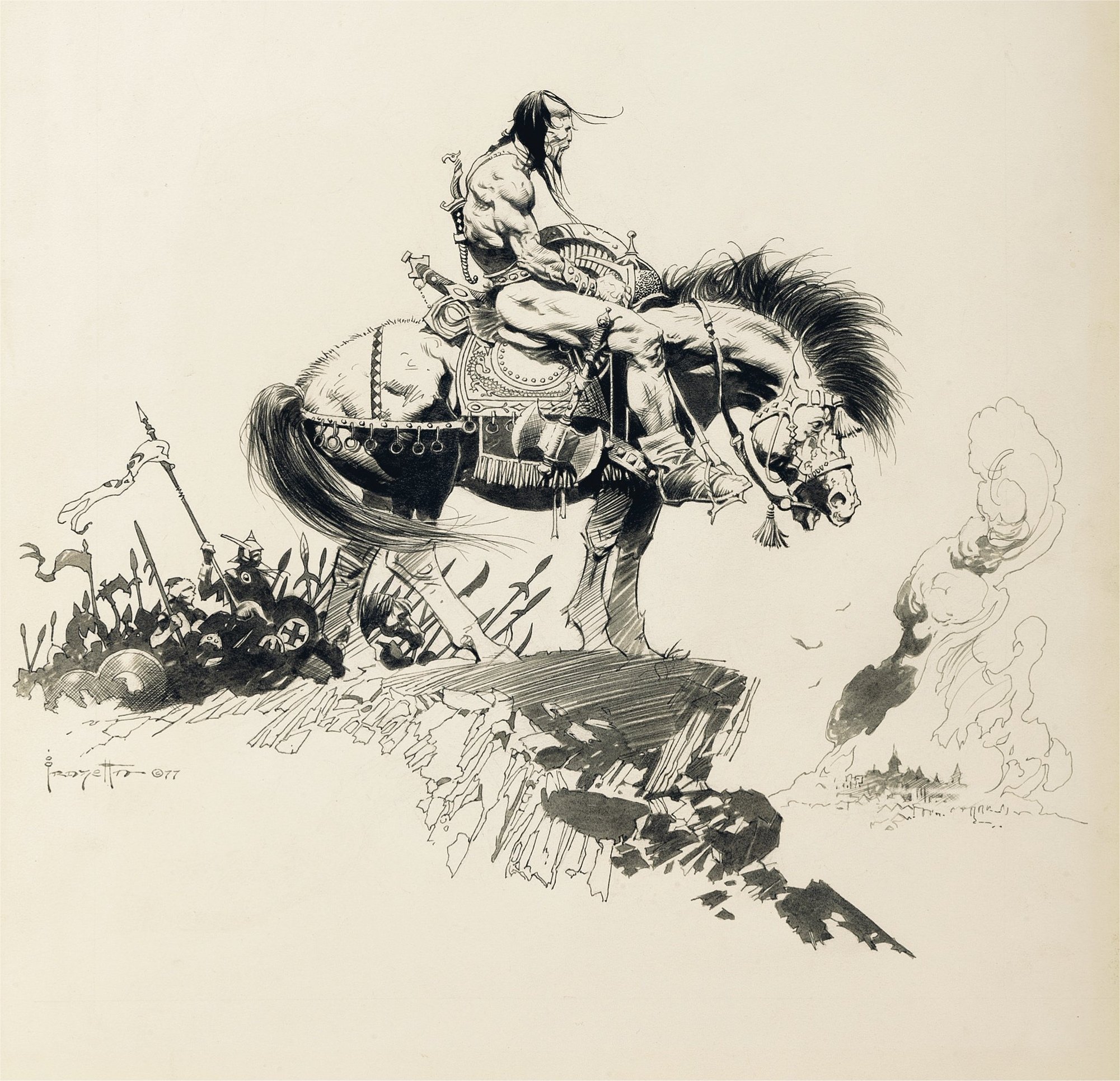 Page 1: Stanzas 1 and 2 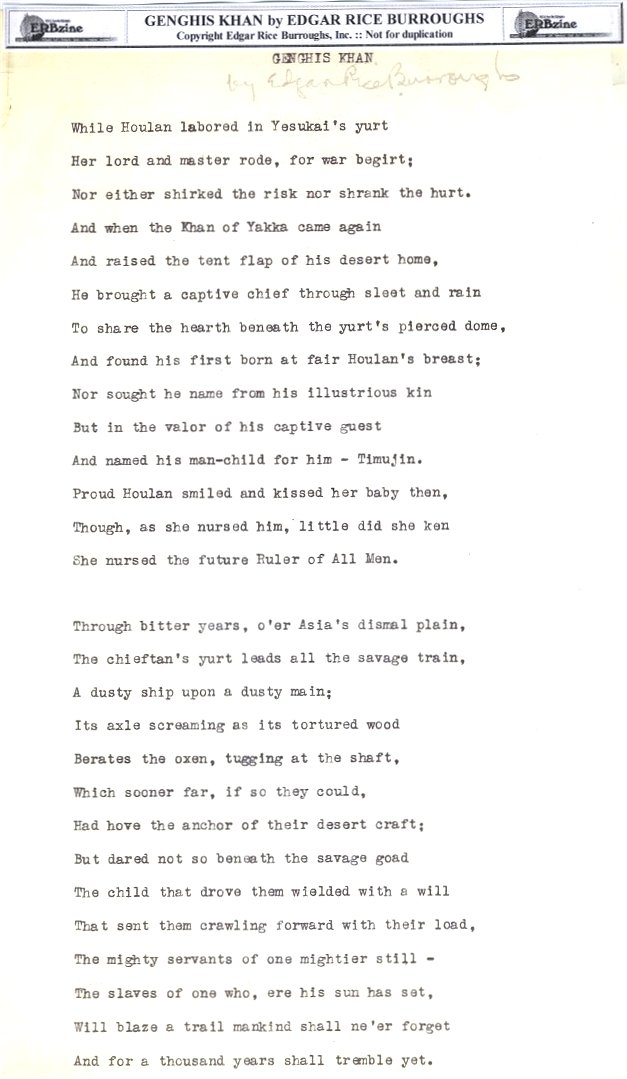
Page 2: Stanzas 3 and 4 (Transcribed from ERB's original typed manuscript by Bill Hillman) Born to the iron of Gobi's savage womb Where Onan flows beside Creation's tomb And Northern lights great Baikul's breast illume; So early weaned from woman's milk to mare's, And thrust by elders from the warming fire To fight the cur pack which, with bristling hairs, Dispute with him the food they all require 'Til Spring shall bring the milk to mare and cow And fat the sheep and fetch the deer and bear To fill the bellies that are empty now While Winter winds moan through the frozen air; The child survives, as in the Cosmic dawn Two clashing Suns brought forth their planet spawn And marked the trail down which his sires had gone. Inevitable, then, that Timujin Should face the rigors of that life and win Eternal glory in the battle's din. As yet a child in stature and in years He tends the horse herds by the reedy lakes That dot the great plateau that boldly rears So near the clouds, where howling wind storm takes Its toll of suff'ring, while it gives to him The attributes that are to make him known In glory fear nor hate may ever dim -- The Scourge of God, who mastered every throne; The Perfect Warrior he, whose god was gore; Who slew a brother in the days before His beard; who was to slay his millions more. Page 3: Stanzas 5 and 6 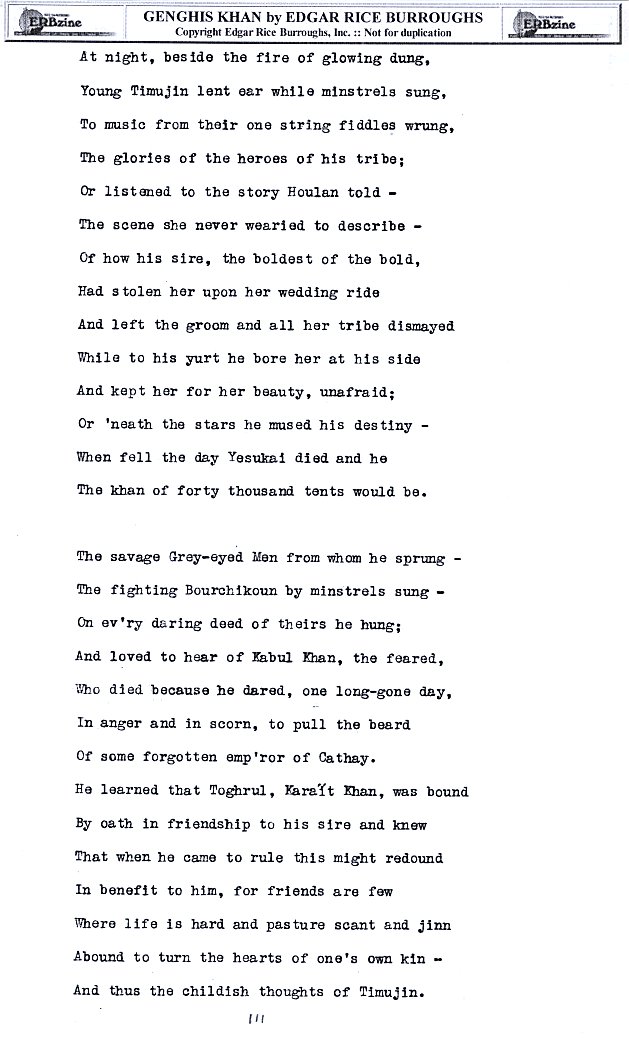
|
|
Deleted
Deleted Member
Posts: 0
|
Post by Deleted on Apr 27, 2017 17:03:37 GMT -5
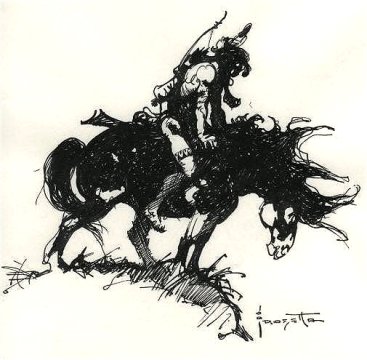 Page 4: Stanzas 7 and 8  Page 5: Stanzas 9 and 10 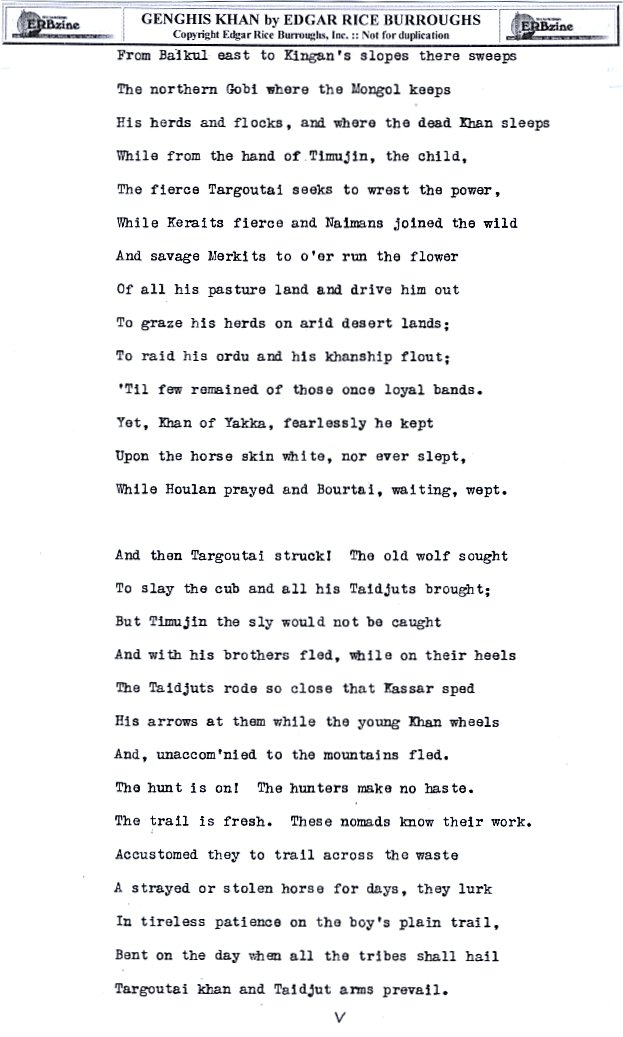 Page 6: Stanzas 11 and 12 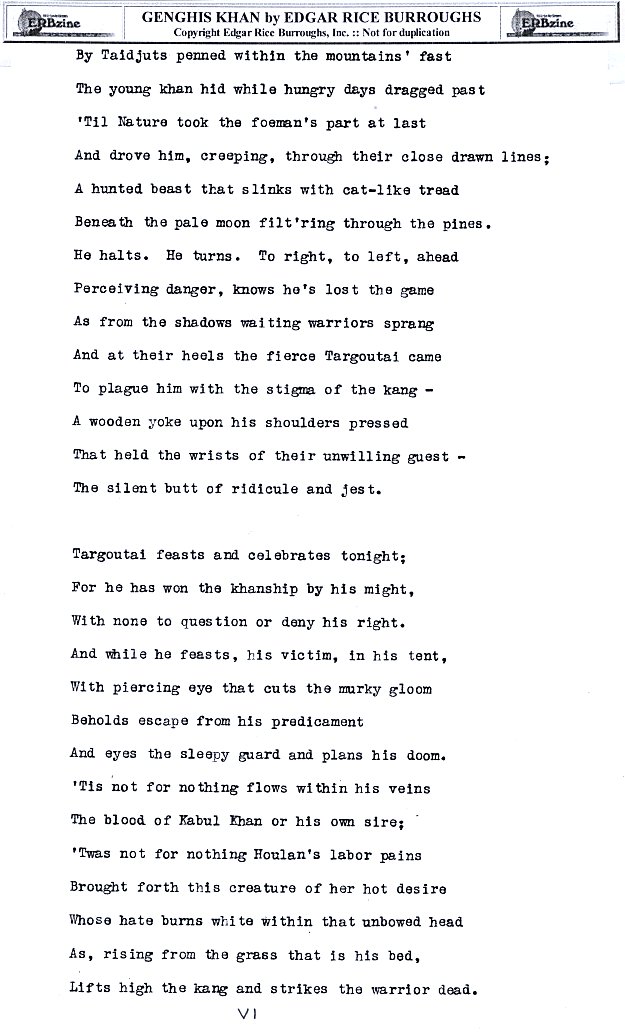 |
|